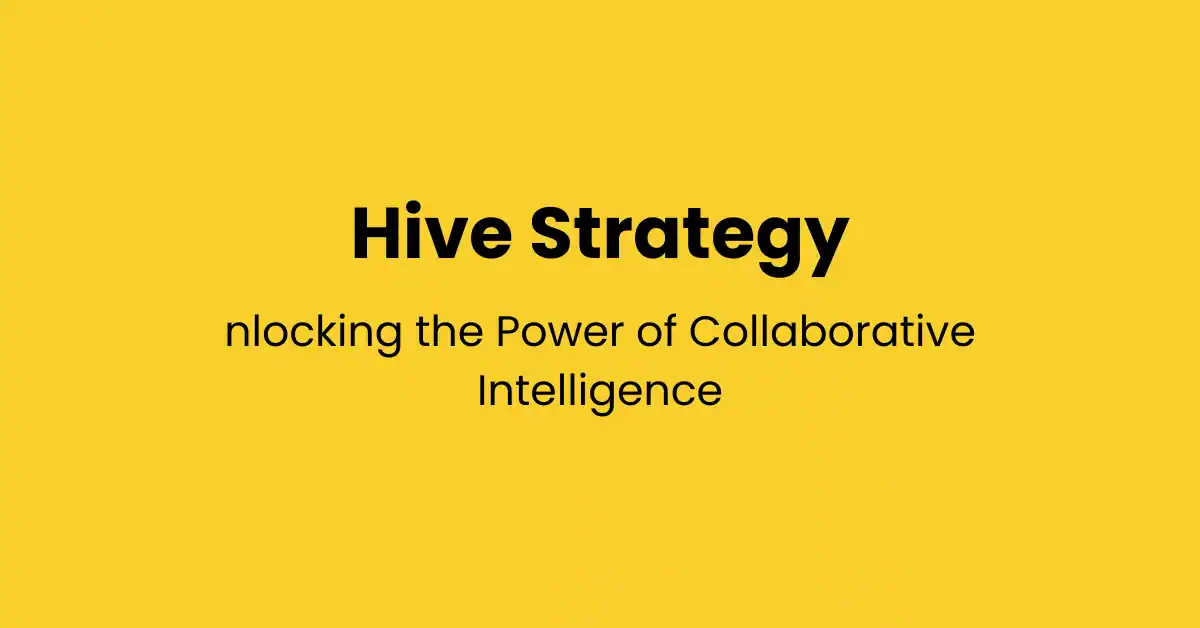In today’s fast-paced world, where collaboration and innovation are more important than ever, the term Hive Strategy has emerged as a game changer. So, what is it exactly? At its core, Hive Strategy is all about harnessing the collective intelligence of a group to drive better outcomes.
It draws inspiration from nature—think of a beehive, where each bee plays a unique role, contributing to the hive’s overall success. By working together, teams can solve problems more creatively and efficiently.
Table of Contents
ToggleThe Importance of Hive Strategy in Business
Why should businesses care about Hive Strategy? Well, in an era marked by rapid technological advancements and shifting market dynamics, organizations that fail to adapt risk falling behind. Here’s how Hive Strategy can make a difference:
Enhancing Team Collaboration
One of the standout features of Hive Strategy is its ability to boost collaboration. Imagine a workplace where team members communicate openly, share ideas freely, and support one another’s initiatives. That’s what a hive-like environment looks like! This synergy leads to increased creativity and innovative problem-solving.
Improving Decision-Making Processes
Traditional decision-making can often be a bottleneck, but Hive Strategy changes the game. By involving diverse perspectives, teams can arrive at better-informed decisions more quickly. When everyone contributes, you’re more likely to avoid pitfalls and seize opportunities.
Key Principles of Hive Strategy
To effectively implement Hive Strategy, it’s crucial to understand its core principles.
Collective Intelligence
Collective intelligence is the cornerstone of the Hive Strategy. It’s about pooling knowledge and expertise from various team members to achieve a common goal. When individuals bring their unique strengths to the table, the result is a richer, more comprehensive understanding of challenges and solutions.
Agile Adaptability
In a constantly changing landscape, adaptability is key. Hive Strategy encourages teams to be agile, enabling them to pivot quickly in response to new information or circumstances. It’s about embracing change rather than fearing it!
Shared Ownership
Shared ownership fosters a sense of accountability among team members. When everyone feels responsible for the project’s success, motivation and commitment naturally increase. This sense of belonging transforms a group of individuals into a cohesive unit.
Implementing a Hive Strategy in Your Organization
Ready to embrace Hive Strategy? Here’s how to get started:
Assessing Your Current Culture
Before diving in, it’s essential to evaluate your organization’s current culture. Are there existing silos that hinder collaboration? Understanding your starting point will help you identify areas for improvement.
Building the Right Team
A successful Hive Strategy requires a diverse team with complementary skills. Think about the mix of personalities and expertise you need. This diversity will be your greatest asset!
Fostering Open Communication
Encourage a culture of transparency and openness. When team members feel safe to express their ideas and concerns, collaboration flourishes. Consider regular check-ins or brainstorming sessions to keep communication flowing.
Tools and Technologies to Support Hive Strategy
To facilitate collaboration, consider leveraging tools and technologies designed to support Hive Strategy.
Collaboration Platforms
Platforms like Slack or Microsoft Teams can revolutionize the way your team communicates. They provide a space for sharing ideas, documents, and feedback in real time, making collaboration seamless.
Project Management Software
Tools such as Trello or Asana help teams stay organized and focused. They enable everyone to see what tasks are being worked on and who is responsible for what. This clarity can enhance accountability and drive progress.
Case Studies: Successful Hive Strategies in Action
Real-life examples speak volumes. Let’s look at a couple of companies that have effectively implemented Hive Strategies:
Company A: Revolutionizing Product Development
Company A embraced Hive Strategy to streamline its product development process. By forming cross-functional teams that included marketing, design, and engineering, they were able to bring new products to market faster than ever. The result? Increased market share and happier customers!
Company B: Enhancing Customer Experience
Company B utilized Hive Strategy to enhance its customer experience. By involving customer service representatives in product design discussions, they were able to gather valuable insights from frontline staff. This approach led to a more user-friendly product and a significant uptick in customer satisfaction.
Challenges of Implementing a Hive Strategy
While Hive Strategy offers numerous benefits, it’s not without its challenges. Here are a couple to watch for:
Resistance to Change
Not everyone is on board with change. Some team members may be resistant to shifting from traditional methods to a more collaborative approach. It’s essential to address these concerns head-on and demonstrate the benefits of Hive Strategy.
Balancing Autonomy and Control
Finding the right balance between allowing autonomy and maintaining control can be tricky. You want your team members to feel empowered, but you also need to ensure that everyone is aligned with the organization’s goals. Clear communication and defined roles can help mitigate this challenge.
The Future of Hive Strategy
What’s next for Hive Strategy? Let’s explore a couple of trends:
Trends to Watch
As businesses continue to evolve, the focus on collaborative intelligence will only grow. Expect to see more organizations adopting Hive Strategy principles to stay competitive.
The Role of AI and Automation
Artificial intelligence and automation are set to play significant roles in the future of Hive Strategy. By leveraging AI tools, teams can analyze data more efficiently, allowing them to make better-informed decisions faster.
Conclusion
In conclusion, it is not just a buzzword; it’s a powerful approach to collaboration that can transform the way teams work together. By embracing collective intelligence, agile adaptability, and shared ownership, organizations can enhance creativity, improve decision-making, and ultimately drive success. If you’re ready to take your team to the next level, it’s time to embrace the hive!
FAQs
1. What are the key benefits of implementing it?
Implementing a Hive Strategy enhances collaboration, improves decision-making, fosters creativity, and increases employee engagement.
2. How can I assess my organization’s readiness for it?
Evaluate your current culture, communication practices, and willingness to embrace change. Surveys and feedback sessions can help gauge readiness.
3. What tools can support a Hive Strategy?
Tools like Slack, Microsoft Teams, Trello, and Asana can facilitate communication and project management, making collaboration more efficient.
4. How do I overcome resistance to change within my team?
Address concerns directly, provide training, and highlight the benefits of Hive Strategy to encourage buy-in from team members.
5. Can small businesses benefit from it?
Absolutely! Small businesses can leverage Hive Strategy to enhance teamwork and innovation, leading to better products and services.






